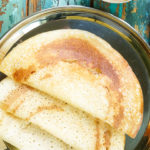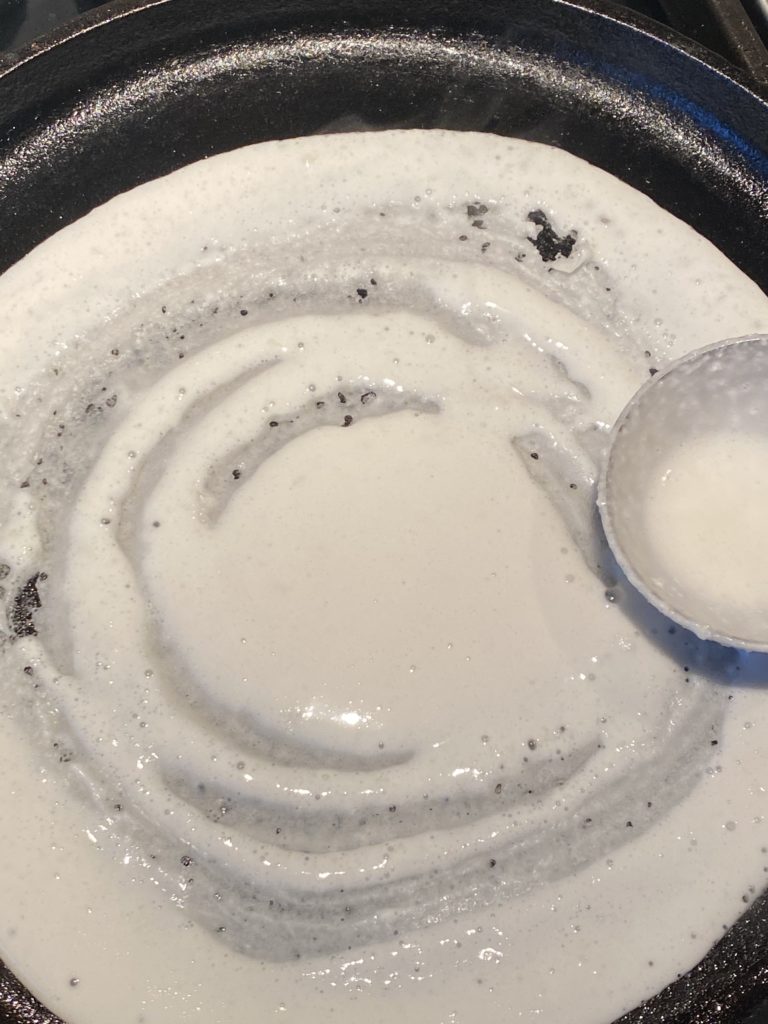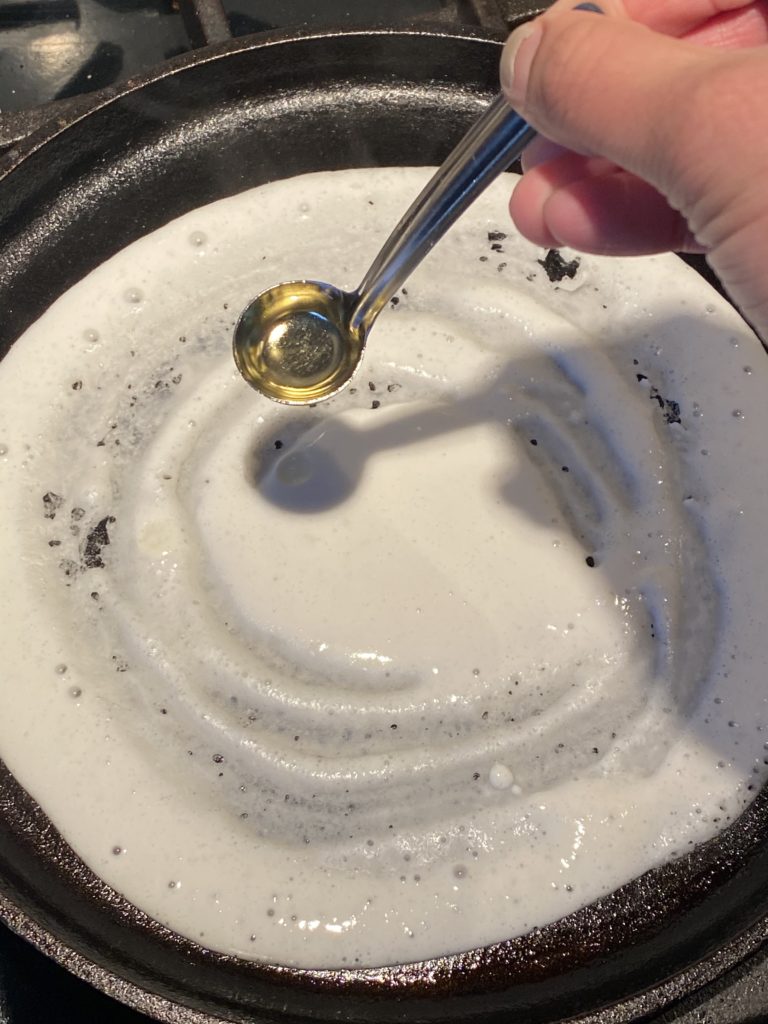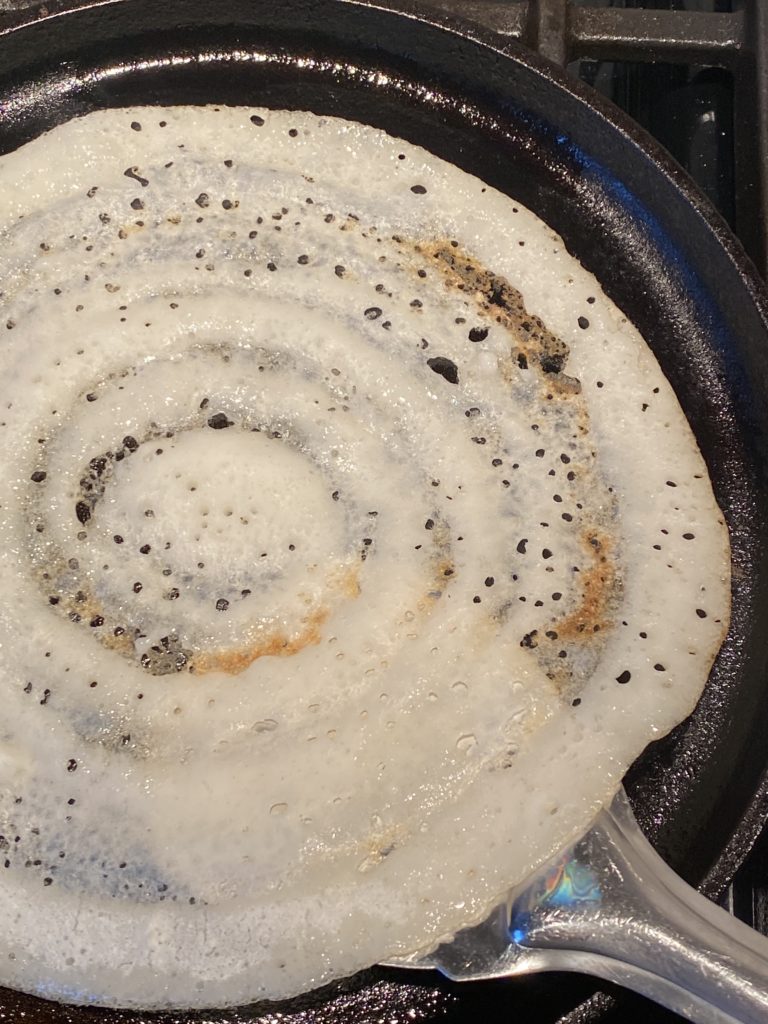
Dosa or Dosai is a savory crispy crepe style pancake of Southern Indian origin. Dosa is made with fermented batter of white rice and urad dal, so it is gluten free as well. Learn how to make the perfect crispy dosas with all tips and tricks and answers to frequently asked questions.

The foundation of a good dosa is a great dosa batter. This comprehensive guide to making that perfect fermented dosa batter is a good start to making great dosas.
I have been making dosas from the age of 12 when I started helong my Amma make dosas for the rest of the family for dinners or breakfasts. I have helped out in making the batter, mixing it, grinding it and all that from the age of 8 or so. This is in my genetic makeup, so to speak 🙂
To make dosas, you can make the dosa batter from scratch at home or you can buy ready to use dosa batters from any Indian grocery store. I will stay away from instant dosa powders. They just don't have the same taste and don't ferment well enough.
Method to make dosa
- Take about 3 cups of thick dosa batter in a large bowl and add about ½ cup water to make it to a thin pancake or a crepe batter consistency.


- Heat the griddle on medium high heat.

- Drizzle a little oil on it and rub it all through the surface of the griddle with a bunched up paper towel. Make sure you take a large piece of paper towel and have it bunched up well, so that you don't accidentally touch the hot griddle with your bare hands.




- Once you can feel the heat on the griddle when you hold your hand near it, sprinkle a little water on it. If it sizzles and evaporates right away, the griddle is ready. This also kinda tempers the griddle a little before the dosa batter goes on it.

- Now using a stainless steel ladle, pour about ¾ to 1 cup worth of batter (estimate this amount, you will have a better idea once you make one or two dosas) in the center of the griddle.
- Slowly work the batter in a concentric circle towards the edge of the griddle using the back of the ladle to spread it.





- Drizzle oil over the top and along the edges of the dosa.


- Wait for 1 minute or so, till you see the edges or any translucent bits of the dosa start to brown and crisp up.


- Using a flat spatula (a stainless steel one works better than a wooden one), gently lift up the dosa from the outer edges all around it.
- Work the spatula under the dosa and make sure the dosa is not sticking to the pan anywhere.




- Gently flip the dosa over. You can drizzle some more oil if needed, but mostly you won't need it.

- The other side will take considerably less time to cook through than the first side. In about 30-40 seconds, you can flip the dosa again and fold it in half and transfer to a serving plate.
What kind of pan to use?
Non stick dosa pans and cast iron griddles are the commonly used types of dosa pans. If you are just starting to learn how to make dosas, it is ok to use a non stick pan. Both non-stick and cast iron pan makes nice and crispy dosas. It is easier to make dosas in it and you can perfect your dosa making skills before graduating to a cast iron pan.
If looking to buy a non stick dosa pan, you can opt for any of the Indian brands like Nirlep or Futura on Amazon. You can also buy any non-stick crepe pan. Or just about any non-stick skillet without a big lip will work just fine.
For cast iron pans, the Lodge cast iron griddle is the best out there. A 10-inch pan works best for homemade dosas.
How to make sure the dosa doesn't stick to the pan?
This is one of the major problems everyone faces when trying to make crispy dosas. They stick to the pan and break when you try to flip it or lift it off the pan. This usually happens with cast iron pans. Nonstick pans should not have this problem, unless the pan is damaged, in which case you should toss it. Here are a few tips to help with that.
- Use a pan exclusively to make dosas. I don't know what the science behind this is. But in all Southern Indian homes, there is always a griddle that is just for dosas and another one for rotis and anything else.
- Season the pan well and keep it well-seasoned.
- All cast iron pans come pre-seasoned. Just wash it with a little bit of soap and warm water, the first time before use.
- To season a pan, pour about 2 tsps of high heat avocado or olive oil on the pan over medium heat. ( I wouldn't use coconut oil or ghee or any oil that will solidify when cold, for this) Sesame oil works too. Using a paper towel, rub the oil in well and let it sit on medium heat till the oil smokes. Add some more oil and repeat the process. Wipe it down one more time, let it cool and store the pan.
- After use, do not wash it with soap. Just wipe with a paper towel and some oil and that is enough. If absolutely required, you can wash it with just some water, but wipe it dry right away and use the previous step to season it.
- Every time you use the pan, it keeps seasoning itself and forms a nice non-stick coat on top. Avoid soap and water and you can keep it seasoned well all the time.
- Sometimes for some reason, if the seasoning wears off or you washed it the last time you used and did not season well, here is a quick tip to season it again before making dosa. Cut half an onion. Use it to re-season the pan by rubbing some oil on to the pan with it. Hold the onion half with a fork to do so.
- I have also heard that mixing an egg or two to some of your dosa batter and making dosa with it or scrambling an egg or two on the pan will help season it too, but I haven't personally tried that.
- It may take a few uses to get it fully seasoned but don't give up, keep using it to make thicker non-crispy dosas a few times and remember to wipe it down with oil after every use.
- After every dosa, use the bunched up paper towel and rub down the griddle surface to distribute any leftover oil to any spots that got a little dry.

How to make dosas to get crispy?
Everyone wants a crispy dosa, right? When my brother and I were little, we used to always ask for “muru muru” or “murugal” dosai, which translates to crispy dosais. Amma used to entice us to eat just one more dosai by making it extra crispy. They are just tastier and dinner to eat.
To make crispy dosas, make sure the batter you just got fermented is thinned out a little. The thick fermented batter is perfect for idlis but you want them just a little thinner to make perfect crispy dosas. About a ¼ cup of water to every 2 - 3 cups of just fermented batter should do the trick. It depends on how perfect your fermented batter is. I would say, experiment a few times to get the right consistency for the dosa batter.
Drizzle oil on top and the perimeter of the dosa while it is cooking on the griddle. This helps make it crispy and also helps in keeping the pan seasoned with every dosa you make.
Keep the temperature right. If the griddle is too hot, the batter won't spread thinly to make crispy dosas. If the griddle is not hot enough, the batter won't crisp up. Keep it at medium heat at all times. If you think the griddle got too hot, reduce the heat and just sprinkle a little water right before pouring the batter. This will kinda help temper the temperature.
What kind of oil to use?
To make dosas, sesame oil is used traditionally. Not the toasted sesame oil, just regular plain sesame oil.
But I use avocado oil, as that is what I use for my regular cooking and I personally don't love sesame oil on my dosas (I know!!)
To flip or not to flip the dosa
This is a question that is commonly asked and it did not make any sense to me at first, because most all homemade dosas are flipped. That is just how I have seen dosas being made at my home, all my relatives and neighbors homes back in India. It is usually only in restaurants that they don't flip the dosas.
But if you want to not flip the dosas, you will have to spread the batter out all the way, so there is no blob of batter anywhere, and to make sure that it is cooked through, you can cover the dosa with a glass lid.
I always flip the dosas I make at home.
Other pro tips
- The batter is thinned out a little to make dosas. If you make batter in bulk, then take out a little at a time and add water to it.
- Try not to dip your ladle into the big batch of batter after using it to spread the batter on to the pan. This makes the rest of the unused batter to ferment even more and turn sour faster. Take enough batter to make dosas for that meal into a separate bowl and thin it out.



Serving suggestions
Dosas are typically served with sambar ( a spiced tamarind and lentil curry with vegetables ), a variety of chutneys and molagai podi, also called gunpowder (a spiced lentil powder).
Here are some of our favorite sambar and chutney recipes to accompany dosas
- Tiffin Sambar
- Varutharacha Sambar
- Coconut Chutney
- Kerala Style Pearl Onion Coconut Chutney
- Onion Tomato Chutney
- Thakkali Thokku
The cilantro mint chutney you usually see alongside samosas, are not typically served with dosas and idlis. But there is no rule that says so. So feel free to try that combo if that is what you have on hand.
📖 Recipe

Dosa Recipe
Ingredients
- 3 cups dosa batter
- ¼ cup water
- 3-4 tablespoon avocado oil
Don't forget to check out Step-by-step instructions with photos in the body of the post above
Instructions
- Take about 3 cups of thick dosa batter in a large bowl and add about ½ cup water to make it to a thin pancake or a crepe batter consistency.
- Heat the griddle on medium high heat.
- Once you can feel the heat on the griddle when you hold your hand near it, sprinkle a little water on it. If it sizzles and evaporates right away, the griddle is ready.
- Drizzle a little oil on it and rub it all through the surface of the griddle with a bunched up paper towel. Make sure you take a large piece of paper towel and have it bunched up well, so that you don't accidentally touch the hot griddle with your bare hands.
- Now using a stainless steel ladle, pour about ½ to ¾ cup worth of batter (estimate this amount, you will have a better idea once you make one or two dosas) in the center of the griddle.
- Slowly work the batter in a concentric circle towards the edge of the griddle using the back of the ladle to spread it.
- Drizzle oil over the top and along the edges of the dosa.
- Wait for 1 minute or so, till you see the edges or any translucent bits of the dosa start to brown and crisp up.
- Using a flat spatula (a stainless steel one works better than a wooden one), gently lift up the dosa from the outer edges all around it.
- Work the spatula under the dosa and make sure the dosa is not sticking to the pan anywhere.
- Gently flip the dosa over. You can drizzle some more oil if needed, but mostly you won't need it.
- The other side will take considerably less time to cook through than the first side. In about 30-40 seconds, you can flip the dosa again and fold it in half and transfer to a serving plate.






Comments
No Comments